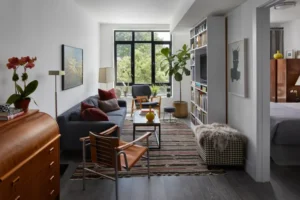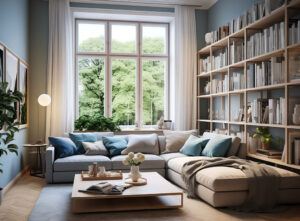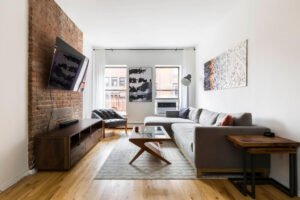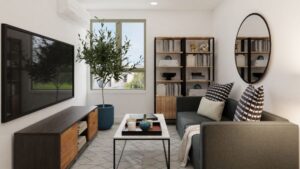How to Decorate a Small Living Room? Decorating a small living room can be both exciting and challenging. The limited space requires creativity and smart planning to make the room not only functional but also stylish and inviting.
Contents
ToggleWhether you live in a cozy apartment or a compact house, designing a small living room can be enjoyable if you have the right strategies. This article explores various tips, tricks, and ideas to help you transform your small living room into a beautiful, comfortable space. Additionally, we’ll address frequently asked questions to help guide you through the process.
Table of Contents
- Understanding Your Space
- Smart Furniture Choices
- Color Scheme and Lighting
- Maximizing Vertical Space
- Mirrors and Reflective Surfaces
- Choosing the Right Decor Elements
- Creating Cozy Zones
- Multi-Functional Furniture
- Decluttering and Minimalism
- Bringing It All Together
1. Understanding Your Space
Before jumping into the decoration process, take some time to assess your living room’s layout. Understanding the dimensions, angles, and natural light sources will help you make better decisions regarding furniture placement, decor, and color choices. Draw a simple floor plan, noting the measurements of walls, windows, and any existing fixtures. Visualizing your space beforehand will give you a clearer picture of what’s possible and how you can make the most out of every inch.
Key Tips:
- Measure your space accurately.
- Identify focal points like windows, doors, or built-in features.
- Observe how light moves through the room during different times of the day.
2. Smart Furniture Choices
Furniture is one of the most critical elements in a small living room. Oversized furniture can overwhelm the space, while tiny pieces might make it feel sparse. Strike a balance by opting for pieces that fit well and provide functionality.
Key Tips:
- Go for Scaled-Down Pieces: Choose furniture that suits the size of the room. For instance, a sleek sofa or loveseat instead of a bulky sectional.
- Use Multi-Functional Furniture: Furniture that serves multiple purposes, such as a storage ottoman, foldable coffee table, or a sleeper sofa, is ideal for small spaces.
- Avoid Cluttered Arrangements: Allow enough room for movement. The layout should be simple, leaving clear walkways and space around the furniture.

3. Color Scheme and Lighting
The color scheme and lighting in your small living room play a significant role in creating an illusion of space. Lighter shades tend to open up a room, while darker hues can make it feel smaller and more enclosed.
Key Tips:
- Opt for Light Colors: Soft hues like whites, pastels, and neutral tones reflect light and give the impression of a larger space.
- Incorporate Contrasting Accents: While light colors dominate the palette, adding some contrasting accents (like darker cushions or artwork) adds depth and interest.
- Maximize Natural Light: Allow as much natural light as possible by using sheer curtains or blinds instead of heavy drapes.
- Layer Artificial Lighting: Use a mix of ambient, task, and accent lighting to brighten the room evenly. Floor lamps, table lamps, and wall-mounted lights are great additions without taking up much space.
4. Maximizing Vertical Space
When floor space is limited, vertical space becomes your best friend. Utilizing walls for storage, decor, and functional items helps free up the room’s footprint while adding visual appeal.
Key Tips:
- Install Floating Shelves: Floating shelves offer a stylish storage solution without taking up floor space. They can hold books, plants, or decorative pieces.
- Use Tall Furniture: Tall bookcases, cabinets, and vertical storage units draw the eye upward, giving the impression of height and spaciousness.
- Hang Artwork Higher: Positioning artwork and photos slightly higher than usual encourages the gaze upward, making the ceiling feel taller.
5. Mirrors and Reflective Surfaces
Mirrors are a classic design trick for small spaces. They reflect light and create the illusion of more space. Strategically placing mirrors and other reflective surfaces can make your small living room feel brighter and more open.
Key Tips:
- Place a Large Mirror Opposite a Window: This reflects natural light, brightening up the room and making it feel more expansive.
- Consider Mirrored Furniture: Items like mirrored coffee tables or reflective wall art can subtly enhance the sense of space.
- Cluster Smaller Mirrors: A collection of small mirrors arranged creatively can work as a stunning focal point while serving the purpose of opening up the room.

6. Choosing the Right Decor Elements
The decor you choose can either enhance the feeling of space or contribute to a cluttered atmosphere. Being selective and intentional with your decorative items is crucial in a small living room.
Key Tips:
- Embrace Minimalism: Keep decor minimal and purposeful. Choose a few statement pieces rather than overcrowding the room with smaller items.
- Use Rugs to Define Areas: In an open-plan living room, rugs can help distinguish different zones without needing physical dividers.
- Go Vertical with Plants: Houseplants add life and freshness but can also take up valuable surface space. Hanging plants or wall-mounted planters are perfect for small living rooms.
7. Creating Cozy Zones
Even in a small living room, it’s possible to create cozy, defined zones for different activities. Zoning can make the room feel larger by giving each area a specific function.
Key Tips:
- Use Furniture Placement to Define Zones: For example, a small reading nook with a chair and lamp can be separated from the main seating area by a slim bookshelf or side table.
- Opt for Area Rugs: Layering rugs helps visually define zones, making each area feel distinct while maintaining an overall cohesive look.
- Play with Lighting: Use different types of lighting for each zone, like a floor lamp for the seating area and a reading light for a cozy corner.
8. Multi-Functional Furniture
As mentioned earlier, multi-functional furniture is essential in small living rooms. Investing in pieces that serve more than one purpose ensures that you’re making the most out of limited space.
Key Tips:
- Sofa Beds and Daybeds: These are perfect for homes that occasionally host overnight guests. They save space while offering comfort and style.
- Storage Ottomans: Use ottomans with built-in storage to keep clutter out of sight. They can double as extra seating or even a coffee table.
- Nesting Tables: Stackable nesting tables can be spread out when needed and tucked away to save space.
9. Decluttering and Minimalism
One of the most effective ways to decorate a small living room is by embracing minimalism. Reducing clutter and focusing on essential items opens up space and creates a calming environment.
Key Tips:
- Purge Unnecessary Items Regularly: Regularly assess what you really need and keep only those items that are functional or truly spark joy.
- Invest in Smart Storage: Hidden storage solutions like built-in cabinets, furniture with hidden compartments, and storage baskets keep clutter out of sight.
- Avoid Over-Decorating: While it’s tempting to add more decor, less is often more in a small living room. Choose a few quality items rather than overwhelming the space with too much decor.
10. Bringing It All Together
Once you’ve considered all the individual elements, the next step is to bring everything together into a cohesive design. The key is to find balance and harmony between furniture, colors, decor, and lighting.
Key Tips:
- Stick to a Theme: A consistent color palette and design style will create a unified look. Whether it’s modern, rustic, or Scandinavian, stick to your chosen theme to avoid a disjointed appearance.
- Incorporate Texture: Layering different textures—like soft rugs, plush cushions, and smooth wood—adds depth and interest without cluttering the room.
- Balance Function and Aesthetics: While it’s essential to have a visually pleasing living room, prioritize functionality. Every item should serve a purpose while also fitting into the overall aesthetic.
FAQs
1. What is the best color scheme for a small living room? Light colors like whites, soft grays, pastels, and neutrals are ideal for small living rooms. They reflect light, making the room feel airy and open. You can add depth and interest with pops of darker colors in accents or decor.
2. How can I make a small living room look bigger? You can make a small living room look bigger by using mirrors, choosing light color schemes, maximizing vertical space with tall furniture or shelves, and selecting appropriately scaled furniture. Avoid overcrowding the room with too many items, and maintain a minimalist approach.
3. How should I arrange furniture in a small living room? In a small living room, focus on creating a functional layout that maximizes space. Start with the essential pieces like the sofa and arrange them to allow clear movement. Use multi-functional furniture, keep walkways clear, and ensure that each piece serves a specific purpose.
4. What kind of sofa is best for a small living room? A small or mid-sized sofa, loveseat, or a sectional with a chaise can work well in a small living room. Opt for sleek designs with legs that expose more floor space, creating a sense of openness. Consider modular sofas that can be easily reconfigured based on the room’s needs.
5. How can I decorate a small living room on a budget? Decorating on a budget is possible by repurposing items, choosing affordable decor, and DIY projects. Thrift stores, discount furniture outlets, and second-hand markets are great sources for budget-friendly finds. Focus on high-impact changes like rearranging furniture, painting walls, or adding

